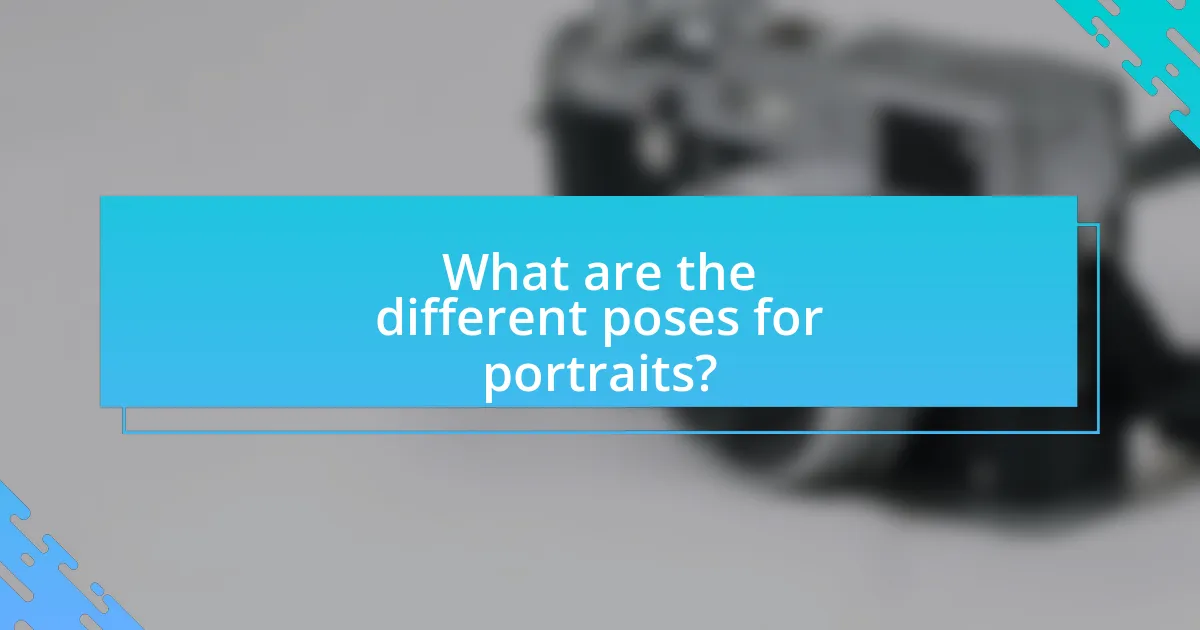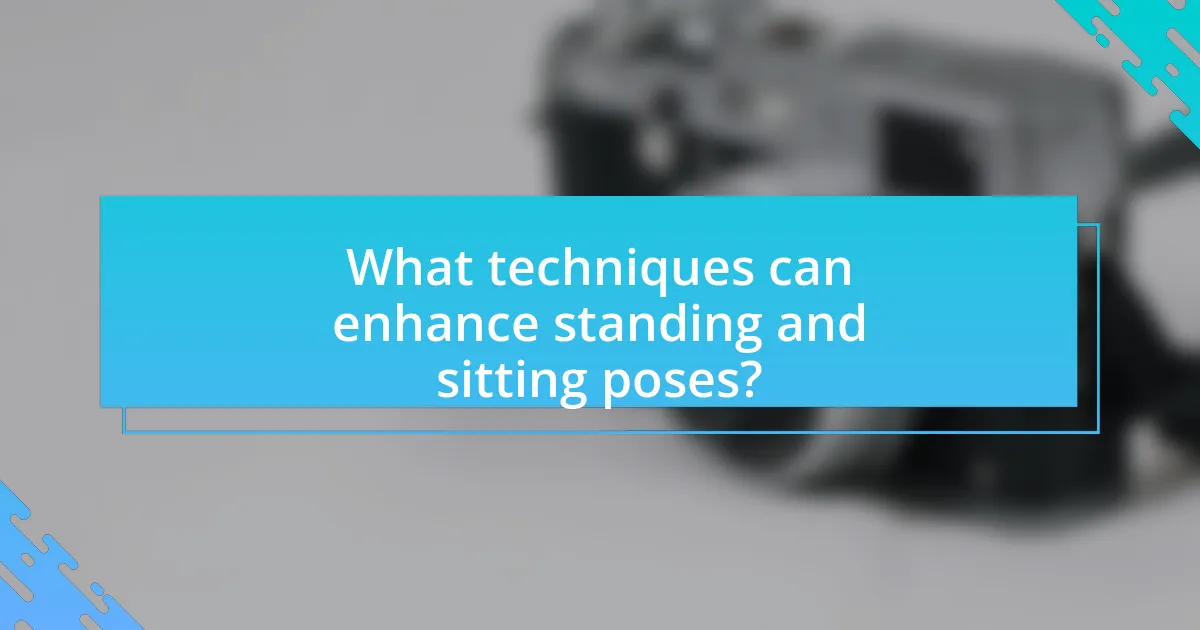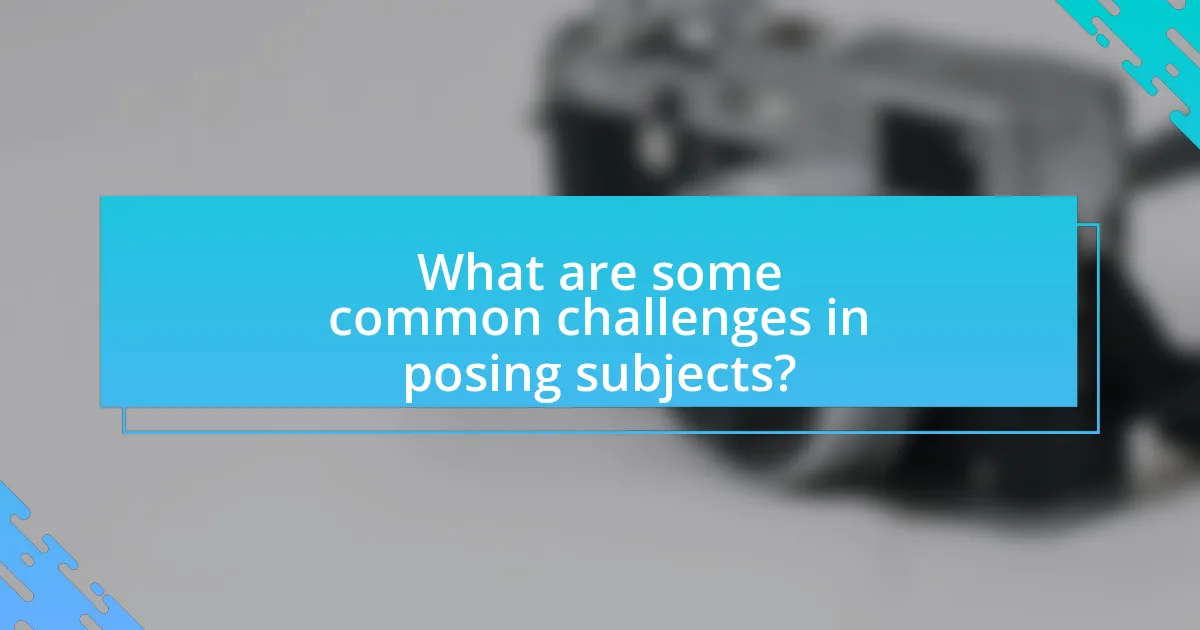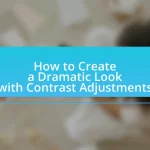The article “From Standing to Sitting: Exploring Different Poses for Portraits” examines various poses used in portrait photography, including standing, sitting, leaning, and dynamic poses. It highlights the emotional and visual impact of each pose, detailing how standing poses convey confidence and strength, while sitting poses create intimacy and relaxation. The article also discusses the importance of pose selection in influencing the subject’s expression and personality, as well as techniques to enhance both standing and sitting poses. Additionally, it addresses common challenges in posing subjects and offers practical tips for photographers to create a comfortable atmosphere, ultimately improving the effectiveness of portrait compositions.

What are the different poses for portraits?
Different poses for portraits include standing, sitting, leaning, and dynamic poses. Standing poses often convey confidence and strength, while sitting poses can create a more relaxed and intimate atmosphere. Leaning poses add a sense of movement and engagement, and dynamic poses involve action or interaction, which can bring energy to the portrait. Each pose serves to express different emotions and characteristics of the subject, enhancing the overall impact of the portrait.
How do standing poses differ from sitting poses in portrait photography?
Standing poses in portrait photography typically convey a sense of confidence and dynamism, while sitting poses often evoke a feeling of relaxation and intimacy. Standing poses allow for a greater range of movement and body language, which can enhance the subject’s presence in the frame. In contrast, sitting poses can create a more grounded and approachable appearance, often highlighting the subject’s facial expressions and upper body. This distinction is supported by the fact that standing poses can emphasize height and posture, while sitting poses can soften the overall composition and create a more personal connection with the viewer.
What are the advantages of standing poses in portraits?
Standing poses in portraits offer several advantages, including enhanced body language expression and a more dynamic composition. These poses allow subjects to convey confidence and engagement, as standing can create a sense of openness and approachability. Additionally, standing poses provide greater flexibility in positioning the body, which can lead to more visually interesting angles and perspectives. Research indicates that body posture significantly influences perceptions of authority and attractiveness, reinforcing the effectiveness of standing poses in portraiture.
What are the advantages of sitting poses in portraits?
Sitting poses in portraits offer several advantages, including enhanced comfort, improved body language, and a more intimate connection with the viewer. Comfort is crucial as it allows subjects to relax, resulting in more natural expressions and poses. Improved body language is achieved through the ability to position arms and legs in ways that convey openness or thoughtfulness, which can enhance the emotional impact of the portrait. Additionally, sitting poses often create a sense of intimacy, making the viewer feel more engaged with the subject, as seen in many classic portrait paintings where seated figures invite closer inspection and connection.
Why is pose selection important in portrait photography?
Pose selection is important in portrait photography because it significantly influences the subject’s expression, body language, and overall visual impact. The chosen pose can convey emotions, highlight features, and create a specific mood, which directly affects how the viewer perceives the subject. For instance, a relaxed pose can evoke a sense of comfort, while a more dynamic pose may suggest energy or confidence. Studies in visual communication indicate that body language accounts for a substantial portion of non-verbal cues, reinforcing the idea that pose selection is crucial for effective storytelling in portraits.
How does pose selection affect the subject’s expression?
Pose selection significantly influences the subject’s expression by altering body language and facial cues. For instance, an upright standing pose often conveys confidence and openness, while a seated pose may suggest relaxation or introspection. Research indicates that specific poses can evoke distinct emotional responses; for example, a study published in the journal “Psychological Science” by Carney et al. (2010) found that power poses can increase feelings of power and reduce stress. Thus, the choice of pose directly impacts how the subject’s emotions are perceived and expressed in portrait photography.
What role does pose play in conveying the subject’s personality?
Pose plays a crucial role in conveying the subject’s personality by visually representing their emotional state, confidence level, and social dynamics. For instance, an open and relaxed pose, such as standing with arms at the sides, often indicates confidence and approachability, while a closed pose, like crossing arms, may suggest defensiveness or discomfort. Research in psychology shows that body language, including posture, significantly influences perceptions of personality traits; for example, a study published in the Journal of Nonverbal Behavior found that observers can accurately assess traits like extroversion and agreeableness based on a person’s pose. Thus, the choice of pose in portraiture directly impacts how the subject’s personality is interpreted by viewers.

What techniques can enhance standing and sitting poses?
Techniques that can enhance standing and sitting poses include proper posture, dynamic angles, and the use of props. Proper posture, characterized by an aligned spine and relaxed shoulders, creates a strong foundation for both standing and sitting poses, improving overall appearance. Dynamic angles, such as turning the body slightly or tilting the head, add interest and depth to the pose, making it more visually appealing. The use of props, like chairs or hands on hips, can provide support and create a more engaging composition. These techniques are supported by studies in photography and art, which emphasize the importance of posture and angles in creating compelling images.
How can body language influence portrait poses?
Body language significantly influences portrait poses by conveying emotions and personality traits through posture and gestures. For instance, an open posture with relaxed arms and a slight lean forward can suggest confidence and approachability, while crossed arms may indicate defensiveness or discomfort. Research in nonverbal communication shows that body language can affect perceptions; a study by Burgoon et al. (2016) in the Journal of Nonverbal Behavior found that specific postures can enhance or diminish the perceived attractiveness and likability of individuals in photographs. Thus, understanding body language allows photographers to guide subjects in adopting poses that effectively communicate desired traits and emotions.
What are the key elements of effective body language in portraits?
Effective body language in portraits includes posture, facial expressions, and hand positioning. Posture conveys confidence and openness; for instance, an upright stance with shoulders back suggests self-assurance. Facial expressions, such as a genuine smile or relaxed features, enhance emotional connection and engagement with the viewer. Hand positioning, whether relaxed at the sides or gently placed on the hips, can add to the subject’s personality and mood, influencing the overall impression of the portrait. These elements work together to create a compelling visual narrative that resonates with the audience.
How can posture impact the overall composition of a portrait?
Posture significantly impacts the overall composition of a portrait by influencing the subject’s visual presence and emotional expression. A straight posture often conveys confidence and authority, while a slouched posture may suggest vulnerability or introspection. For instance, research in visual perception indicates that upright postures are associated with positive traits, enhancing the viewer’s perception of the subject’s character. Additionally, the angle and position of the body can affect the balance and symmetry of the portrait, guiding the viewer’s eye and creating a more engaging composition.
What props or settings can complement different poses?
Props and settings that complement different poses include furniture, natural elements, and thematic accessories. For instance, a chair can enhance seated poses by providing structure and comfort, while a tree or a park bench can create a relaxed atmosphere for outdoor portraits. Additionally, using props like books or musical instruments can add personality and context to the subject, making the pose more engaging. The choice of background, such as urban settings or serene landscapes, can also significantly influence the mood and effectiveness of the pose, as evidenced by studies showing that environmental context impacts viewer perception in portrait photography.
How do props enhance the storytelling aspect of a portrait?
Props enhance the storytelling aspect of a portrait by providing context and depth to the subject’s narrative. They can symbolize personal interests, cultural backgrounds, or emotional states, thereby enriching the viewer’s understanding of the subject. For instance, a musician holding an instrument conveys a passion for music, while a book can suggest a love for literature. This use of props allows the photographer to create a more engaging and relatable story, making the portrait not just a representation of the subject but a glimpse into their life and experiences.
What settings work best for standing versus sitting poses?
Standing poses work best in settings that allow for full-body visibility and dynamic backgrounds, such as outdoor environments or spacious indoor areas. These settings enhance the subject’s stature and create a sense of movement. In contrast, sitting poses are most effective in intimate or confined spaces, like cozy rooms or on furniture, which provide a sense of comfort and connection. The proximity of the background in sitting poses can also help focus attention on the subject’s facial expressions and body language.

What are some common challenges in posing subjects?
Common challenges in posing subjects include difficulty in achieving natural expressions, managing body language, and ensuring proper alignment. Natural expressions can be hard to elicit, as subjects may feel nervous or self-conscious, leading to forced smiles or awkward poses. Body language is another challenge; subjects may not know how to position their limbs or torso, resulting in stiff or unflattering angles. Proper alignment is crucial for aesthetic appeal, and misalignment can detract from the overall composition of the portrait. These challenges are frequently encountered in portrait photography, where the goal is to capture the subject’s personality and essence effectively.
How can photographers help subjects feel comfortable in different poses?
Photographers can help subjects feel comfortable in different poses by establishing a relaxed atmosphere and providing clear guidance. Creating a friendly environment reduces anxiety, allowing subjects to express themselves naturally. Techniques such as engaging in conversation, using humor, and demonstrating poses can enhance comfort levels. Research indicates that subjects who feel at ease are more likely to produce authentic expressions, leading to better photographs. For instance, a study published in the Journal of Visual Communication in Medicine found that subjects reported higher satisfaction with their portraits when they felt comfortable during the shoot.
What techniques can be used to ease tension in standing poses?
To ease tension in standing poses, practitioners can utilize techniques such as proper alignment, breath control, and mindful engagement of muscles. Proper alignment ensures that the body is positioned correctly, reducing strain on joints and muscles, which is essential for maintaining comfort during poses. Breath control, particularly deep and rhythmic breathing, helps to relax the body and mind, allowing for a more fluid and natural stance. Additionally, mindful engagement of muscles involves consciously relaxing areas of tension while activating others, promoting a balanced and relaxed posture. These techniques are supported by principles of body mechanics and mindfulness practices, which emphasize the importance of awareness and relaxation in physical expression.
What strategies can be employed to create a relaxed atmosphere for sitting poses?
To create a relaxed atmosphere for sitting poses, employing strategies such as using comfortable seating, adjusting lighting, and incorporating calming background music is essential. Comfortable seating, like soft chairs or cushions, allows subjects to feel at ease, reducing tension in their bodies. Proper lighting, preferably soft and diffused, minimizes harsh shadows and creates a warm ambiance, which contributes to relaxation. Additionally, playing calming background music can help alleviate anxiety and foster a serene environment, encouraging natural expressions. These strategies are supported by studies indicating that comfort and ambiance significantly influence a subject’s ability to relax during portrait sessions.
What are the best practices for capturing dynamic poses?
The best practices for capturing dynamic poses include using a fast shutter speed, employing continuous shooting mode, and utilizing natural light to enhance movement. Fast shutter speeds, typically 1/500 seconds or faster, freeze motion effectively, preventing blur. Continuous shooting mode allows photographers to capture multiple frames in quick succession, increasing the chances of obtaining the perfect moment. Natural light, especially during golden hour, adds warmth and depth to the image, making dynamic poses more visually appealing. These techniques are supported by the principles of motion capture in photography, which emphasize the importance of timing and lighting in creating impactful images.
How can movement be incorporated into standing poses for more energy?
Incorporating movement into standing poses can enhance energy by introducing dynamic elements such as shifting weight, subtle rotations, and arm gestures. These movements create a sense of liveliness and engagement, making the pose appear more vibrant. For instance, shifting weight from one foot to the other can activate the legs and create a natural flow, while rotating the torso slightly can add depth and interest to the pose. Additionally, incorporating arm movements, such as raising or extending the arms, can enhance the overall energy and expressiveness of the pose. Research indicates that dynamic poses are perceived as more energetic and engaging, which supports the effectiveness of these techniques in portraiture.
What tips can improve the effectiveness of sitting poses in portraits?
To improve the effectiveness of sitting poses in portraits, ensure the subject maintains good posture by sitting up straight with shoulders back, which conveys confidence and engagement. Additionally, angling the body slightly to the side rather than facing the camera directly can create a more dynamic composition. Incorporating natural hand placements, such as resting hands on knees or in lap, adds to the relaxed feel of the pose. Finally, using props like chairs or stools can enhance the visual interest and provide context to the portrait. These techniques are supported by professional photography practices that emphasize the importance of body language and composition in portraiture.
What practical tips can enhance portrait posing skills?
To enhance portrait posing skills, individuals should focus on body angles, facial expressions, and the use of props. Adjusting body angles can create depth and interest; for example, turning the shoulders slightly away from the camera can produce a more flattering silhouette. Facial expressions should be varied to convey different emotions, and practicing in front of a mirror can help individuals understand their best angles and expressions. Additionally, incorporating props can add context and personality to the portrait, making the pose more engaging. These techniques are supported by photography studies that emphasize the importance of posture and expression in creating compelling portraits.

















